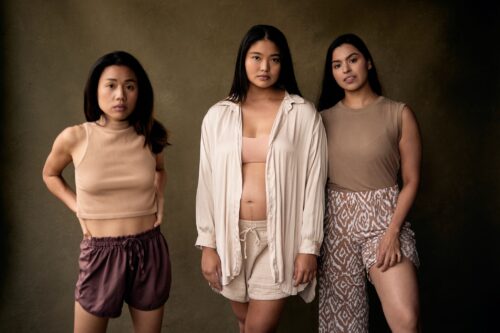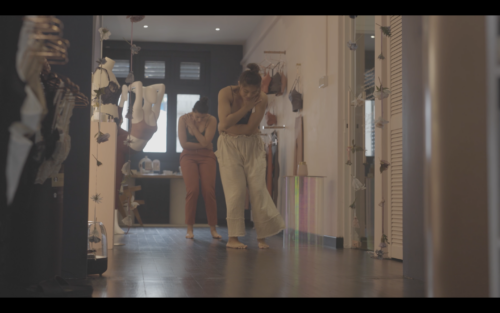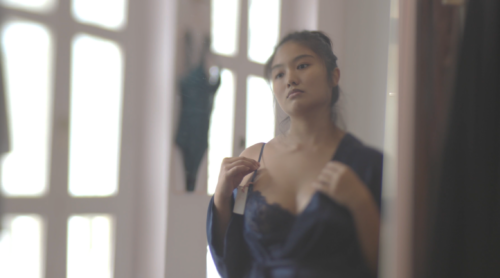Thammika Songkaeo, 2022 International MFA in Creative Writing & Literary Translation
“It’s important to inspire questions. When people ask questions, they inherently link a part of themselves to a topic. We need those connections to be made because they’re a part of engagement, and we’re at a critical time where we need everyone to be engaged for the environment.” -Thammika Songkaeo
In December of 2022, we interviewed Thammika Songkaeo (IMFA ‘22), founder of Two Glasses studio, on her upcoming short film, CHANGING ROOM—a film funded in part by a National Geographic Explorer Grant. We spoke to Songkaeo about Two Glasses, CHANGING ROOM, the inherent connection between the body and the climate crisis, and creating work in the social justice space. Read excerpts from our conversation below.
ON THE FOUNDING OF HER STUDIO, TWO GLASSES
Two Glasses is a studio that experiments with ideas, such as, “Can conversation card games build communities that make people rely less on material satisfaction?” or “What does time spent criticizing our bodies have to do with climate change?” We are a studio in both senses of the word: a space where artists work and a film or television production company.
I founded Two Glasses, whose name is a play on the mispronunciation of my Thai last name, which can make it mean “two glasses”—a very tactile and plain meaning, when the correct pronunciation would reflect a thought more abstract and virtuous. I was running this entity alone for almost a year when my partner, Xin You Tan, dropped down from the skies. We hire other team members based on what we’re working on—an approach that gives us flexibility to find the right people for each project.
We create projects that tackle environmental problems in new and multidisciplinary ways. Our portfolio includes these existing and forthcoming works:
- CHANGING ROOM—a dance film
- A writing retreat that focuses on the ethics of travel writing
- Emerge, Agency—a participatory exhibit shedding light on the environmental cost of dancing for social media attention

ON THE INSPIRATION BEHIND HER UPCOMING SHORT FILM, CHANGING ROOM
CHANGING ROOM is a short, movement-based film that asks, “What does time spent criticizing our bodies have to do with climate change?”
I was frustrated by the dances I saw when I YouTubed “dance climate change.” Dance, like most art forms, is a deeply personal experience, and I didn’t experience appreciation, memorability, and inspiration from the dances I saw. I wondered if I could create a better production, given my resources, and I began to look at who I knew. Luckily, I knew Adelene Stanley, who has danced on world-class stages.
I invited two dancers I respected, including Adelene Stanley, to come into the studio one day to “give me a dance about climate change.” They gave me movement that made me feel no connection or strong emotions, and I quickly learned that the fault was mine, not theirs. These were women who could move, so it was my prompt that was the problem. To overcome this problem… I needed them to feel a wave of emotions, and only then would I be able to tell them, “That’s what I want, when you dance about climate change.” To get them there, I changed the prompt to, “A dance about how you feel about your body”—they didn’t know why I asked for that, but they quickly responded in movement and gave me something that made my heart melt. I began to see meaningful actions: them hitting bellies, flexing muscles, or fumbling with clothes to try to find a more flattering angle. Eyes, when staring at the mirror, began to doubt, scold, and love, before they fumbled with their clothes again. I saw a relationship between their bodies and their clothes. Reflecting on how the fashion industry is a significant contributor to climate change, I asked, “What do you think time spent with your physical insecurities has to do with how you buy clothes?” A conversation erupted. We communally reflected on experiences of how mirrors made us, as women, feel, and how insecurity has been responded to with shopping sprees promising that adorning a body with clothing can make a body “beautiful enough.” “But could it ever be enough, if we are not full inside?” they began to ask. “What happens to the environment in our search to endlessly find clothes to complete us, if we are still empty inside?” we wondered together.
ON THE INHERENT CONNECTION BETWEEN CHANGING ROOMS AND THE CLIMATE CRISIS
Changing rooms, where many scrutinize their own bodies and spend time considering how they’ll fix or hide imperfections, are also often where fantasies of solutions rooted in “the next purchase” begin. When a woman is alone in front of a mirror, she opens up to herself in ways marketers only dream of knowing. The slightest jiggle or a raw, harsh word whispered to herself, instructs that woman what to buy next: Is it a new skirt to cover up the bulging thighs? Spanx to tuck in belly fat? Or even the same shirt, but in a different, more flattering color? These products that we, as women, are encouraged to buy have an environmental effect larger than most people know. It’s estimated that the fashion industry contributes 8-10% to carbon emissions. Our responses to our insecurities feed into the consumption that enables the industry to continue growing.
I hope [CHANGING ROOM] will allow the viewers to look at their relationship with clothing in a more environmentally conscious way, and I hope that the seeming far-fetched-ness of the guiding question will prompt people to begin questioning how other aspects of their lives and mentality may be linked to climate change. They might want to ask, for instance, “How does the way I want to die impact Earth?”

ON THE USE OF DANCE TO TELL THE STORY OF CHANGING ROOM AND THE INCLUSION OF MOVEMENT THERAPY AT FILM SCREENINGS
In dance, the body speaks. CHANGING ROOM is the story of the body’s experience interacting with a mind, in a way that many women (and men), no matter what language they speak, can identify with. Because the film speaks to a universal experience, it also made sense to consider whether we needed words. Why would we use words, which aren’t universally accessible, when the body can say what we need to say to everyone who’s watching?
In the premiere and various in-person screening experiences worldwide, our audiences will flow after the screening into Movement Therapy, where they will look at themselves in a non-judgmental way, deepen their self-love, and become more self-aware, so that they leave empowered to live without the old pressures of relying on appearance, and what clothes they wear, for confidence.
ON HOW HER TIME AT VCFA HELPED INFORM HER ART AND SOCIAL JUSTICE WORK
I learned that, in my art, anything goes if I do it well, and to me, doing well becomes conflated with doing something differently, intelligently, and bravely. I needed to figure out “What is the art that I can make that nobody else can?” as wholesomely as possible. In other words, “How do I get the least formulaic to come out of me?”
In social justice efforts, I feel there’s also space for less formulaic efforts. There’s a point of diminishing returns after formulas are said over and over, and people stop listening. If you want them to listen, you have to hear what they’re currently hearing, and you have to feel if their ears are full, and you have to provide a new solution. Sometimes, you have to provide a new sense, or speak to a new sense altogether.

ON HOW ART CAN HELP PEOPLE TACKLE ENVIRONMENTAL AND SOCIAL JUSTICE ISSUES
I think art needs to also look outside of itself. Yes, as artists, we can create things based on the mediums that we personally enjoy and we can tell our own stories—and at some point in life, we’ll likely run into that work that we need to create solely for ourselves—but there are advantages to putting other people’s minds first and seeing ourselves more as the orchestrator of their potential when it comes to environmental and social issues. Art should inspire questions that trigger self-examination. At the end of the day, “environmental and social justice issues” essentially means “too much of bad stuff happening,” and we need to ask ourselves why we’re creating bad stuff, if we know that they’re bad. Art can get us to know that part of our humanity and decision-making—and then we can address that root cause, towards something better.
ON HOW TO WATCH CHANGING ROOM
If you’re in Singapore, you can view CHANGING ROOM on June 3rd & 4th 2023 at The Projector—Singapore’s premiere independent movie theater. If you’re abroad, you can contact us if you’d like to see the film in person and experience the Q&A and Movement Therapy that are part of the Singapore screening package.
Stay up-to-date with the CHANGING ROOM at twoglasses.org/changing-room and on Instagram at @changingroomproject.
(Images: Screenshot images from CHANGING ROOM courtesy of Thammika Songkaeo; Photos taken by Crispian Chan)

